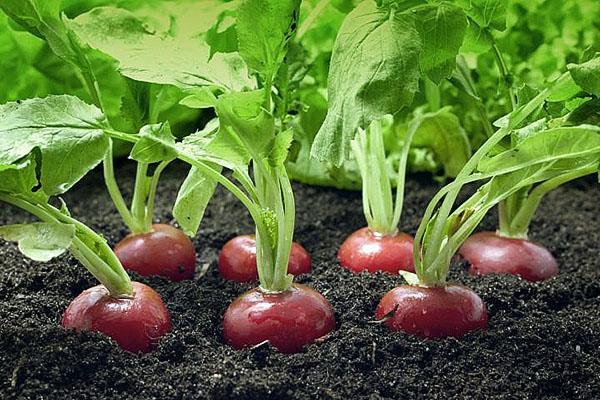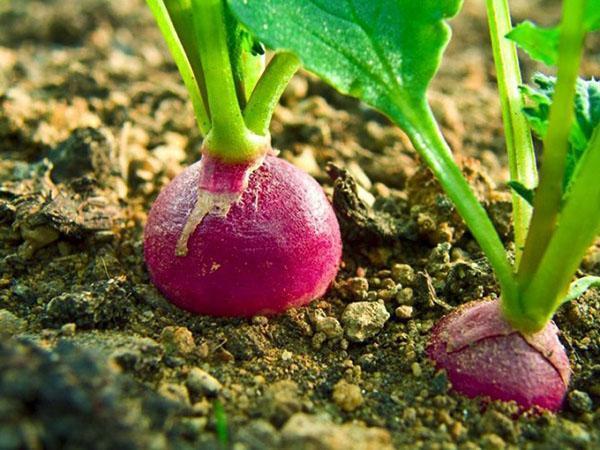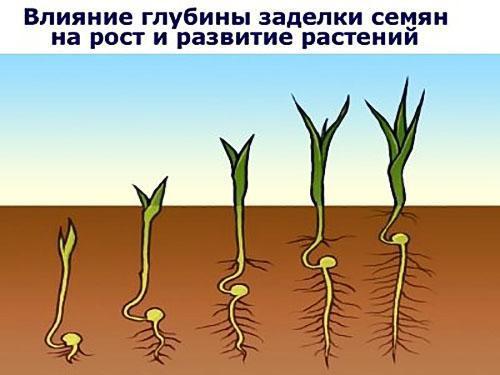When is the spring planting of radishes in open ground
 The growing season of radish has a short duration, so it is a favorite of many summer residents. And when to plant radishes in open ground in spring remains a controversial issue, because each region has individual climatic characteristics.
The growing season of radish has a short duration, so it is a favorite of many summer residents. And when to plant radishes in open ground in spring remains a controversial issue, because each region has individual climatic characteristics.
Regions favorable for growing vegetables

High cold resistance makes it possible to grow a culture when night temperatures drop to -5 C °, and daytime temperatures should not be lower than 9 C °. Only under such conditions will the germination capacity be poor and the quality of vegetables low.
In the Moscow region, planting of radishes in open ground begins in mid-April - early May, when the sun begins to warm the earth. The optimal temperature for growing a vegetable is considered to be + 20 ° C, but at 15 ° C the radish will also grow, only the shoots will appear a little later. To make the sprouting process go faster, the bed is covered with a film or the crop is planted in a greenhouse. And in the southern regions, sowing begins at the end of March, when the weather is favorable for planting radishes in the ground, for example, in the Rostov region and the threat of frost has passed.
There is no need to wait until the thermometer rises above 20 degrees. This will not only not improve the quantitative and qualitative indicators of culture, but, on the contrary, will reduce them. The hot sun enhances the growth of the tops, but not the root crop.
Open ground planting rules
 After you have made the decision to sow radishes in your area, you need to carefully consider the choice of seeds:
After you have made the decision to sow radishes in your area, you need to carefully consider the choice of seeds:
- Buy goods only in specialized stores.
- Look closely at the date of production and give preference to more recent samples.
- Choose a variety that suits your conditions and planting period.
Soil preparation is one of the most important stages of planting radishes in spring in open ground.
 In a pre-selected area, which is well illuminated by the sun's rays and protected from strong winds, it is necessary to dig the ground to a depth of 25 - 35 cm. For radishes, loose soil with a neutral PH is suitable. If you are not sure that the soil meets these requirements, you can use the "old-fashioned" method and check the acidity of the soil.
In a pre-selected area, which is well illuminated by the sun's rays and protected from strong winds, it is necessary to dig the ground to a depth of 25 - 35 cm. For radishes, loose soil with a neutral PH is suitable. If you are not sure that the soil meets these requirements, you can use the "old-fashioned" method and check the acidity of the soil.
For this you need:
- pour 5 - 7 leaves of black currant with a glass of hot water;
- insist 8 - 10 minutes and strain;
- put in a container with water a little earth from the intended landing site;
- wait for the liquid to stain.
Red or light burgundy will mean that the soil is acidic, if blue, then the soil is neutral. A green tint indicates that the earth has medium acidity.
After diagnostics, if there is a slight swampiness, it is necessary to add a little lime to the soil.
Plant radishes where vegetables such as tomatoes, cucumbers and potatoes were grown last year, or where you plan to grow tomatoes.
In loamy and depleted soil, you need to add mineral fertilizers taking into account the sown area.
 When the preparation of the seat is completed, it is necessary to make grooves on the garden bed at a distance of 10 - 15 cm from each other.You can sow seeds directly from the packaging bag, and if you want to get strong and large fruits, you need to pre-process the seeds.
When the preparation of the seat is completed, it is necessary to make grooves on the garden bed at a distance of 10 - 15 cm from each other.You can sow seeds directly from the packaging bag, and if you want to get strong and large fruits, you need to pre-process the seeds.
Before planting radishes outdoors, place the seeds in a soft cloth dampened with warm water for 24 hours. Before sowing, soak them in hot water for 15 minutes to avoid rotting. Experienced gardeners, before planting, process the radishes with 1% iodine solution for several minutes and roll them in crumbled chalk so that the seeds are visible on dark soil, and you can control the distance between them.
The radish seeds are laid out in a 1 cm deep moistened furrow at 10 cm intervals to give each root crop enough room to develop.
If sowed in a quick way, then when the plant is picked, nearby shoots may be damaged and not develop further.
 The spring planting of radishes in open ground ends with sprinkling the seeds with earth, and on top with a small amount of ash.
The spring planting of radishes in open ground ends with sprinkling the seeds with earth, and on top with a small amount of ash.
Vegetable crop care
 Planting and caring for radishes in the open field does not have complex nuances, but it requires certain rules to be followed that help to grow juicy and large vegetables. This includes:
Planting and caring for radishes in the open field does not have complex nuances, but it requires certain rules to be followed that help to grow juicy and large vegetables. This includes:
- watering;
- loosening;
- fertilization with mineral mixtures;
- mulching;
- weeding.
 Radish is a moisture-loving plant, so the size and taste of the root crop will depend on the amount of watering. If the humidity is low, the radish will be bitter and tough.
Radish is a moisture-loving plant, so the size and taste of the root crop will depend on the amount of watering. If the humidity is low, the radish will be bitter and tough.
It is necessary to water the radish only from a watering can, so that a strong jet from the hose does not damage the grown stems and does not wash out the roots.
To better retain moisture in the garden, add mulch to the topsoil using humus, plain paper or special film for garden crops.
 In between waterings, you should carefully loosen the ground around the plant so that the main part does not rot, and the soil is filled with oxygen. It is necessary to water the garden with radishes regularly, because weeds can slow down the development of the sprout and take the necessary trace elements from the soil.
In between waterings, you should carefully loosen the ground around the plant so that the main part does not rot, and the soil is filled with oxygen. It is necessary to water the garden with radishes regularly, because weeds can slow down the development of the sprout and take the necessary trace elements from the soil.
It is better to apply mineral fertilizers to the garden bed when the radish is planted in the open ground in spring. But to accelerate the growth and development of root crops, urea and mullein are used, which are diluted in a proportion of 1 teaspoon per 200 ml of water, respectively. This solution is used to treat the matured sprouts. If you use a combined feeding, then it is better to give preference potash fertilizers.
Never use fresh manure!
When radishes are planted in open ground under a film, the plant care algorithm is preserved, only the obligation to open and close the film every day is added until good weather conditions are established.